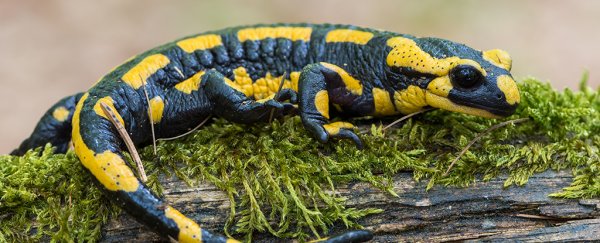Unlike some creatures, humans can't regenerate their limbs – but a new study suggests we do have a hidden 'salamander-like' ability to regrow cartilage in the body, a finding which could help treatment for joint injuries and even arthritis.
Using mass spectrometry techniques on 18 specimens, researchers were able to identify a mechanism by which we repair tissue around our ankles, knees and hips - and it's similar to the mechanism amphibians use to sprout new legs.
It's the first time researchers have comprehensively hunted for signs of regeneration in human tissue, and it appears that in some joints, we're better at repairing cartilage than anyone previously thought. If scientists are able to build upon this, those healing properties could be boosted even further.
"We believe that an understanding of this 'salamander-like' regenerative capacity in humans, and the critically missing components of this regulatory circuit, could provide the foundation for new approaches to repair joint tissues and possibly whole human limbs," says physiologist Virginia Byers Kraus, from the Duke University in North Carolina.
The team collected 18 specimens of joint tissue from the hips, knees or ankles of patients who underwent surgery. They then placed the tissue in a mass spectrometer and measured the number of proteins in the sample.
They started their analysis by determining the age of cartilage tissue proteins, finding that proteins in the knee were younger than those in the hip – as in, they showed fewer signs of the natural ageing that occurs. The proteins in the ankle were younger still.
This might explain why hips and knee joints are more susceptible to arthritis than the ankles, and why injuries of the former typically take longer to heal. Interestingly, it also matches up with animals with regenerative abilities, where regeneration usually happens more easily at the tips of the body, not the core.
The protein readings also matched up with a further study of microRNA levels: these molecules regulate the process of cartilage repair, and again, they're more active in self-healing animals like salamanders and zebrafish.
"We were excited to learn that the regulators of regeneration in the salamander limb appear to also be the controllers of joint tissue repair in the human limb," says physiologist Ming-Feng Hsueh, from Duke University. "We call it our 'inner salamander' capacity."
"We believe we could boost these regulators to fully regenerate degenerated cartilage of an arthritic joint," says Kraus. "If we can figure out what regulators we are missing compared with salamanders, we might even be able to add the missing components back and develop a way someday to regenerate part or all of an injured human limb."
The researchers think the presence of microRNA might be traced to some point far back in our evolutionary history. According to their results, microRNA molecules were more active in the ankles than in the knees, and more active in the knees than in the hips.
The mixing of microRNA with other compounds to be used as targeted drugs is an emerging field of research, but in the case of boosting our regenerative abilities, it's not yet clear what those other compounds might be. If further studies can throw some light on that, we might be looking at a treatment for osteoarthritis, for example – a type of arthritis caused by a breakdown of cartilage around the bones.
We're still a long way from that sort of treatment, let alone being able to regrow arms and legs. For now, further research could investigate whether cells near our extremities are actually intrinsically better at regenerating, or whether they're just in a biological environment that's better suited to cartilage regeneration.
Finding this initial link between human and animal regeneration is promising though: it's one of numerous ways that scientists are looking at how the human body could be encouraged to better repair itself.
"We believe this is a fundamental mechanism of repair that could be applied to many tissues, not just cartilage," says Kraus.
The research has been published in Science Advances.
